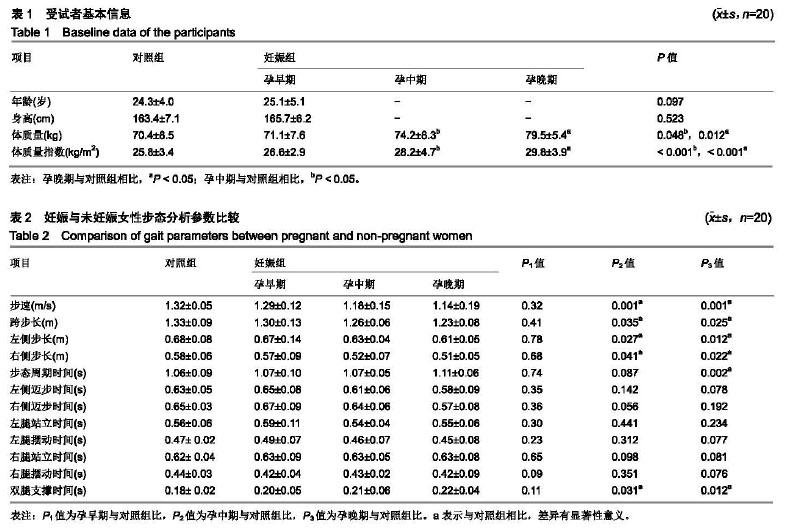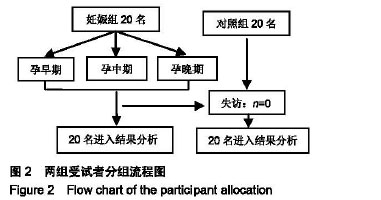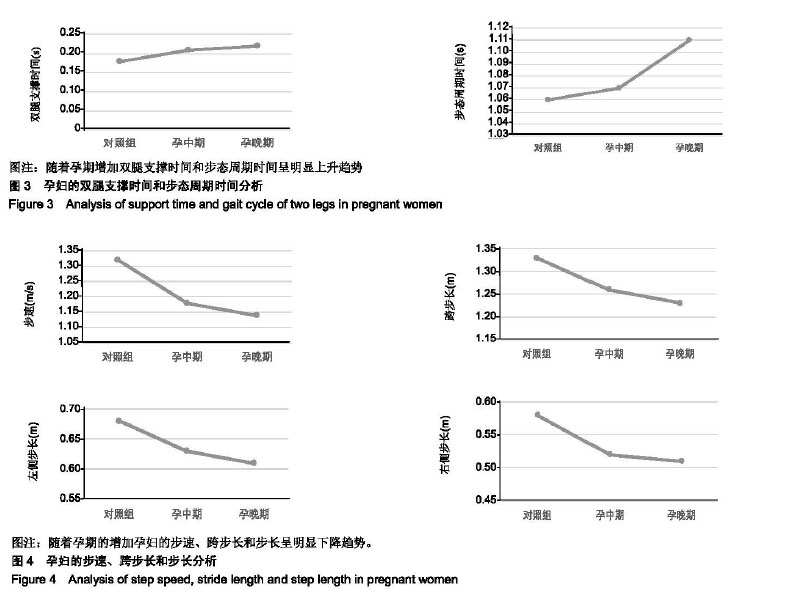中国组织工程研究 ›› 2019, Vol. 23 ›› Issue (27): 4310-4314.doi: 10.3969/j.issn.2095-4344.1377
• 肌肉肌腱韧带组织构建 tissue construction of the muscle, tendon and ligament • 上一篇 下一篇
不同孕期孕妇的步态特征
陈雪梅1,王从笑2,郭文玲1,马建林3,李 伟2
- (滨州市中心医院,1产科,3急诊科,山东省滨州市 251700,2首都医科大学附属北京康复医院康复诊疗中心,北京市 100144)
Gait characteristics of pregnant women in different pregnancy periods
Chen Xuemei1, Wang Congxiao2, Guo Wenling1, Ma Jianlin3, Li Wei2
- (1Department of Obstetrics, 3Department of Emergency, Binzhou Central Hospital, Binzhou 251700, Shandong Province, China; 2Center for Rehabilitation, Beijing Rehabilitation Hospital of Capital Medical University, Beijing 100144, China)
摘要:
文章快速阅读:
.jpg) 文题释义:
步态分析:是指对肢体运动特征的系统研究,研究主要使用仪器辅助测量身体的运动,身体的机械结构,以及肌肉的活跃度等。步态分析被广泛用于对个体走路能力的评估、计划、治疗和康复中。
妊娠分期:妊娠期亦称怀孕期,是胚胎和胎儿在母体内发育成熟的过程。临床上通常分为3个时期:13周末之前称为早期妊娠,第14-27周末称为中期妊娠,第28-40周末称晚期妊娠。
文题释义:
步态分析:是指对肢体运动特征的系统研究,研究主要使用仪器辅助测量身体的运动,身体的机械结构,以及肌肉的活跃度等。步态分析被广泛用于对个体走路能力的评估、计划、治疗和康复中。
妊娠分期:妊娠期亦称怀孕期,是胚胎和胎儿在母体内发育成熟的过程。临床上通常分为3个时期:13周末之前称为早期妊娠,第14-27周末称为中期妊娠,第28-40周末称晚期妊娠。
.jpg) 文题释义:
步态分析:是指对肢体运动特征的系统研究,研究主要使用仪器辅助测量身体的运动,身体的机械结构,以及肌肉的活跃度等。步态分析被广泛用于对个体走路能力的评估、计划、治疗和康复中。
妊娠分期:妊娠期亦称怀孕期,是胚胎和胎儿在母体内发育成熟的过程。临床上通常分为3个时期:13周末之前称为早期妊娠,第14-27周末称为中期妊娠,第28-40周末称晚期妊娠。
文题释义:
步态分析:是指对肢体运动特征的系统研究,研究主要使用仪器辅助测量身体的运动,身体的机械结构,以及肌肉的活跃度等。步态分析被广泛用于对个体走路能力的评估、计划、治疗和康复中。
妊娠分期:妊娠期亦称怀孕期,是胚胎和胎儿在母体内发育成熟的过程。临床上通常分为3个时期:13周末之前称为早期妊娠,第14-27周末称为中期妊娠,第28-40周末称晚期妊娠。摘要
背景:怀孕女性由于身体结构和激素水平的变化,其摔倒和摔伤的风险会明显高于未怀孕的同龄妇女。目前的研究显示步态特征的变化与跌倒的发生存在紧密的联系,因此关于不同孕期步态稳定性的研究对孕妇跌倒的预防具有重要的意义。
目的:通过分析不同孕期孕妇的步态特征,探讨孕妇在不同妊娠阶段维持步态稳定性的侧重点,为预防孕妇跌倒的发生提供参考建议。
方法:研究经过滨州市中心医院伦理委员会审批通过(审批号:2018-039)。采集20名妊娠妇女(妊娠组)和20名未妊娠的同龄妇女(对照组)步态运动学数据,所有受试者均签署知情同意书。妊娠组采集时间分为3个阶段进行,即孕12周内(早期妊娠),>12-28周(中期妊娠)和>28-40周(晚期妊娠)。使用便携式步态分析系统测试受试者的步态参数。
结果与结论:①随着妊娠月份的增加,患者的部分步态参数与妊娠前相比,有明显的统计学差异;②早期妊娠妇女与健康对照组的步态数据差异均无显著性意义(P > 0.005);③孕中期妇女与健康对照组相比,其步速明显降低, 跨步长明显变短,左下肢步长变短,右下肢步长变短,双腿支撑时间明显延长;孕晚期妇女与健康对照组相比,其步速同样明显降低, 跨步长明显变短,左下肢步长变短,右下肢步长变短,步态周期时间明显延长,双腿支撑时间明显延长;而这些变化则是为了更好维持孕妇的稳定性,防止孕妇的跌倒发生。
中图分类号:



.jpg)
.jpg) 文题释义:
步态分析:是指对肢体运动特征的系统研究,研究主要使用仪器辅助测量身体的运动,身体的机械结构,以及肌肉的活跃度等。步态分析被广泛用于对个体走路能力的评估、计划、治疗和康复中。
妊娠分期:妊娠期亦称怀孕期,是胚胎和胎儿在母体内发育成熟的过程。临床上通常分为3个时期:13周末之前称为早期妊娠,第14-27周末称为中期妊娠,第28-40周末称晚期妊娠。
文题释义:
步态分析:是指对肢体运动特征的系统研究,研究主要使用仪器辅助测量身体的运动,身体的机械结构,以及肌肉的活跃度等。步态分析被广泛用于对个体走路能力的评估、计划、治疗和康复中。
妊娠分期:妊娠期亦称怀孕期,是胚胎和胎儿在母体内发育成熟的过程。临床上通常分为3个时期:13周末之前称为早期妊娠,第14-27周末称为中期妊娠,第28-40周末称晚期妊娠。